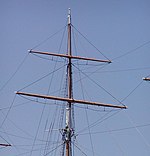
Back صار Arabic Мачта (корабоплаване) Bulgarian Gwern (bag) Breton Pal (nàutica) Catalan Stěžeň Czech Mast Danish Schiffsmast German Masto Esperanto Mástil Spanish Laevamast Estonian


The mast of a sailing vessel is a tall spar, or arrangement of spars, erected more or less vertically on the centre-line of a ship or boat. Its purposes include carrying sails, spars, and derricks, giving necessary height to a navigation light, look-out position, signal yard, control position, radio aerial or signal lamp.[1] Large ships have several masts, with the size and configuration depending on the style of ship. Nearly all sailing masts are guyed.[2]
Until the mid-19th century, all vessels' masts were made of wood formed from a single or several pieces of timber which typically consisted of the trunk of a conifer tree. From the 16th century, vessels were often built of a size requiring masts taller and thicker than from single tree trunks. On these larger vessels, to achieve the required height, the masts were built from up to four sections (also called masts). From lowest to highest, these were called: lower, top, topgallant, and royal masts.[3] Giving the lower sections sufficient thickness necessitated building them up from separate pieces of wood. Such a section was known as a made mast, as opposed to sections formed from single pieces of timber, which were known as pole masts.
Those who specialised in making masts were known as mastmakers.
- ^ Layton, Cyril Walter Thomas, Peter Clissold, and A. G. W. Miller. Dictionary of nautical words and terms. Brown, Son & Ferguson, 1973.
- ^ Harland, John. Seamanship in the Age of Sail, pp. 22–5, Naval Institute Press, Annapolis, Maryland, 1992. ISBN 0-87021-955-3.
- ^ Keegan, John (1989). The Price of Admiralty. New York: Viking. pp. 278&281. ISBN 0-670-81416-4.